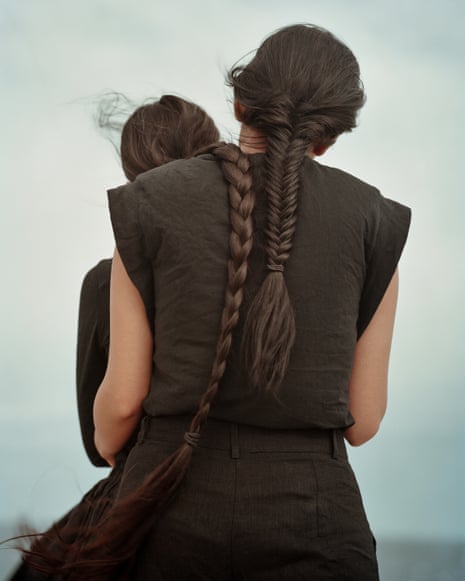
Hair-plaiting for the Iranian resistance: Hoda Afshar’s best photograph
‘This was inspired by a daily ritual in which female fighters in the mountains plait each other’s hair while chanting: “Woman, life, freedom.” It was a response to the death of Mahsa Jina Amini in Iran’
I was born in Tehran but have been living in Australia since 2007. This was taken as the uprisings in Iran were unfolding, following the 2022 death in custody of Mahsa Jina Amini, a Kurdish woman who was arrested by the country’s morality police, igniting protests. This image is part of a bigger series called In Turn, commissioned for A Curve Is a Broken Line, an exhibition at the Art Gallery of New South Wales in Sydney last year. I wanted to use this platform to respond to what was happening, and what we saw in images emerging from Iran and circulating on social media. One motif was the act of plaiting hair, historically symbolising sisterhood, bonding and resistance. This tradition extends to the Kurdish women’s liberation movement, where as a daily ritual in the mountains, female fighters plait each other’s hair while chanting the slogan “Jin, Jiyan, Azadî” – “Woman, Life, Freedom”. Amini’s Kurdish heritage sparked the Woman, Life, Freedom movement that followed her death, turning hair-plaiting into a symbol across Iran.
It was a female-led uprising. We were waking up every morning to news of deaths of protestors, but seeing the bravery of women – especially young ones – defying mandatory hijab laws gave us hope, as did men joining in the fight. But we were mourning too: people were dying for women’s rights. Despite the increasing strength of daily rallies, the regime’s violence escalated in tandem.
I wanted everyone to wear black for consistency; it wasn’t about individuality but about collective grieving and resistance, which lay at the heart of the movement. I used an old large-format camera on the rooftop of a house in early spring, overlooking the ocean. It was windy – I secured the camera with lots of ropes to a table. I used the sky as the backdrop because it’s something we all share as humans.
after newsletter promotion
It was freezing, so the sisters were holding each other while standing on a table, awaiting my directions. The older one has very long hair: she hasn’t cut it since she left Iran because it carries her memories of home. So she draped it over her younger sister’s shoulder because she didn’t want the braid to get tangled. I was adjusting the camera and, right in that moment, I saw the two of them. I was like: “Do not move!” The pose wasn’t staged; they were seeking warmth in each other’s embrace. If you look closely, you can see goosebumps on the younger sister’s arms.
As soon as I developed the films, this photograph was the first one I sent to my own sister, who is still in Iran. I miss her a lot. I remember one morning during the uprisings, she called and told me that a bullet had passed her ear on the streets. I couldn’t sleep for days. I was thinking: “What if I wake up in the morning and she’s gone?”
I want this photograph to be a reminder of care and love. We’re living in a very dark time. I never thought, after the situation in Iran in 2022 and 2023, that I would ever feel as mournful again. But with the current state of the world and the war in Gaza, we’re seeing things I never thought I’d see with my own eyes. There is a new level of grieving and despair. That’s why images like this are so important. They give us a glimpse of love and care.

Hoda Afshar’s CV
Born: Tehran, Iran, 1983
Trained: “A bachelor’s degree in fine art, majoring in photography, at Islamic Azad University in Iran; a PhD in creative arts at Curtin University in Perth, Australia”
Influences: “The poetry of Hala Alyan, Ilya Kaminsky and Elyas Alavi. The Cinema of Andrei Tarkovsky, Claire Denis and Abbas Kiarostami. I also watched a lot of Ingmar Bergman’s films before shooting this series”
High point: “Making work on Manus Island in Papua New Guinea with refugees who had been detained by the Australian government for my project Remain”
Low point: “When I first moved to Australia, I found it very difficult to make work that was relevant. I couldn’t connect to this new country”
Top tip: “Stay true to yourself and don’t get caught up in following trends. Don’t fret over expectations. Create what holds meaning for you and resonates genuinely with your heart”
Source: theguardian.com



